Smoke Tree: Complete Care Guide (Including Royal Purple Smoke Tree)
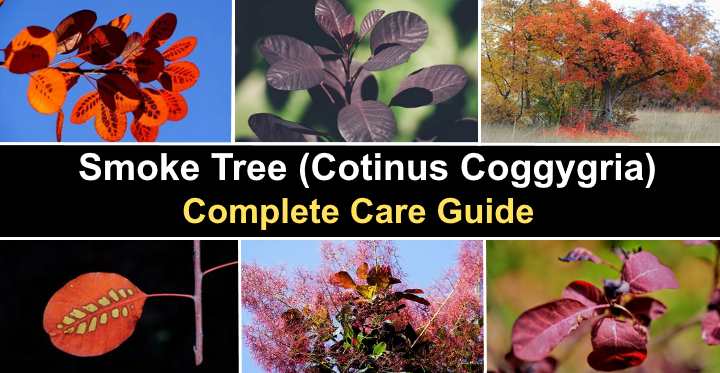
The smoke tree is a stunning large shrub or small multi-stemmed tree with eye-catching purple or green foliage and feathery flower clusters resembling puffs of pink smoke. Also called smoke bush, the colorful deciduous tree creates a spectacular visual interest in a garden landscape from spring until fall. In addition, a smoke tree requires little maintenance, making it an ideal ornamental shrub for growing in most climates.
This article is a guide to growing a smoke tree in your front or backyard. In addition, you will find out about various types of smoke trees with colorful foliage in shades of dark purple, light pink, and chartreuse green.
About the Smoke Tree (Cotinus coggygria)
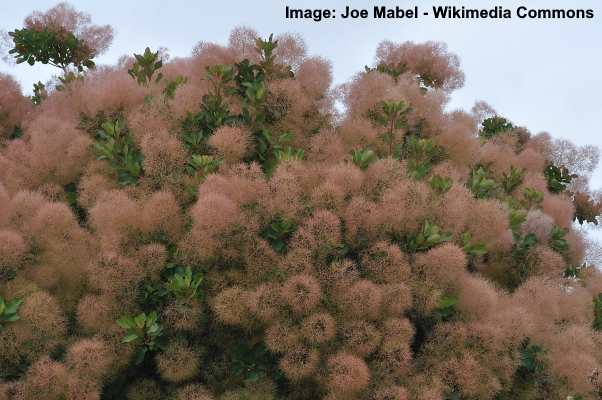
The smoke tree (Cotinus coggygria) is a multi-branching shrub that can be trained to grow as a tree
The smoke tree or smoke bush is a deciduous shrub that can be trained to grow as a tree. The multi-branching shrub has oval or rounded leaves and pink feathery plumes. Smoke trees grow 16 to 23 ft. (5 – 7 m) tall and have a spreading, irregular habit.
The smoke tree’s colorful dark foliage and flowers make it a popular ornamental plant in garden landscapes. Although pinkish-purple is the color that most defines smoke bushes, there are varieties with yellow, yellowish-green, or deep red flowers. In addition, the shrub’s leaves can range in shades of purple before turning red, yellow, or orange in the fall.
Varieties of smoke trees are cold-hardy large plants that thrive in USDA zones 4 through 9. Smoke trees tend to perform best in full sun to partial shade, which helps maintain their vibrant foliage.
The name smoke tree comes from the smoke-like appearance of the wispy spent flower clusters (inflorescences). When in bloom, the puffs of flowers give the small tree a hazy appearance. Other names for Cotinus coggygria include European smoketree, smokebush, dyer’s sumach, and Venetian sumach.
Smoke trees are medium-growing woody multi-stemmed shrubs. However, the ornamental plant is relatively short-lived and typically grows for around 20 years. But most gardeners agree that the beauty a smoke tree brings to a yard is worth it.
Smoke Tree Flowers
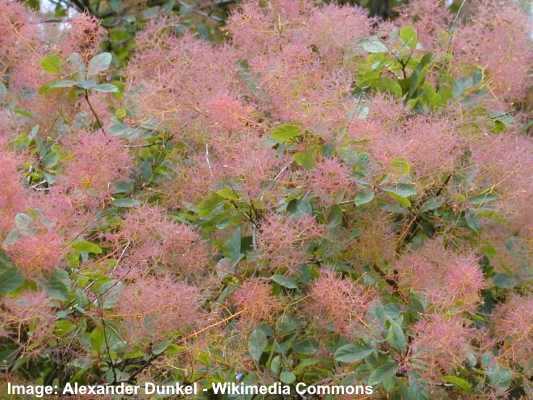
The smoke tree spent flowers give the tree its characteristic fuzzy appearance
Flowers on the smoke tree are distinctive airy plume-like panicles consisting of small five-petalled flowers. However, the fine hair-like filaments on the spent flower stems are the identifying feature of the plant, giving the smoke tree its fuzzy appearance. The long flower clusters can measure 6” to 12” (15 – 30 cm) long.
Typically, smoke tree flowers are a pinkish-purple color. The puffy blooms appear in late spring or early summer. After the flowers fade, the panicles persist on the tree, where the fuzzy puffs of smoky clusters give the tree its identifying characteristic.
Although the smoke tree flowers are usually vibrant pink hues, the plumes can be shades of red, orange, yellow, or creamy-white.
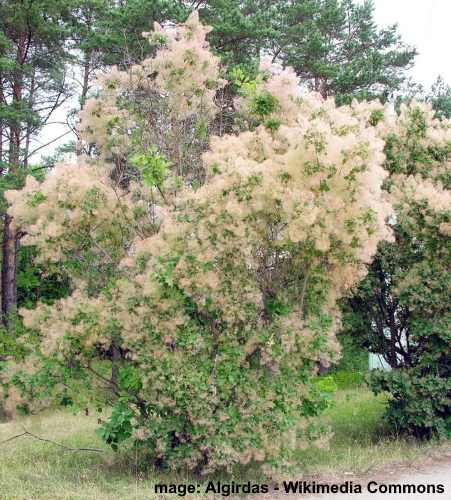
Smoke tree with creamy white flowers
Smoke Tree Leaves
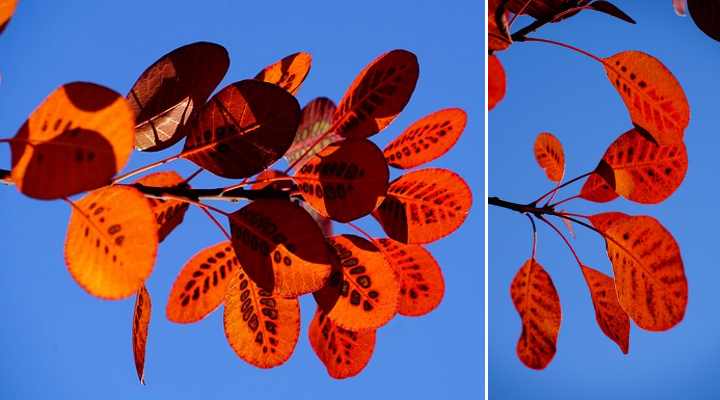
Smoke tree leaves in autumn
Leaves on the smoke tree are identified as colorful, showy rounded ovate leaves that emerge in colors of deep red, smoky purple, chartreuse, and bluish-green. The attractive foliage keeps its color throughout summer before turning orange, dark red, deep purple, and yellow in the fall. Smoke tree leaves measure 1.2” to 3.2” (3 – 8 cm) long.
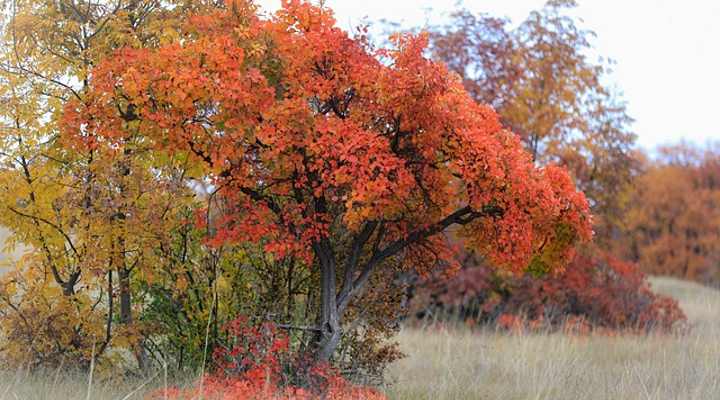
Smoke tree – autumn foliage
Being a deciduous plant, smoke trees lose their leaves in the fall. When the colors of the leaves change, some species of smoke tree leaves take on spectacular multi-colored patterns. For example, the species of some smoke trees have fall colors of vibrant oranges with dark purple designs. Other leaves turn deep orange with light green marks.
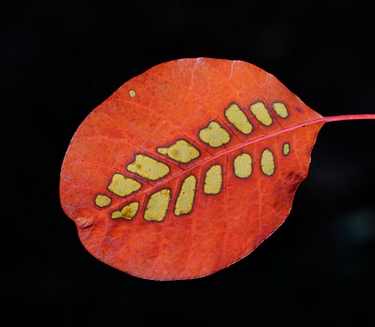
Smoke tree autumn leaf
Crushed leaves have a spicy aroma like radish.
Smoke Tree Size
A smoke tree is classified as a sizable multi-branching shrub or small tree. Depending on the species, a smoke tree measures between 8 feet (2.4 m) tall and 15 feet tall (4.5 m).
The smallest species is the ‘Golden Spirit’ smokebush at 8 feet tall (2.4 m). The tallest smoke trees are the ‘Royal Purple’ and ‘Velvet Cloak,’ growing 10 to 15 (3 – 4.5 m) feet tall.
Smoke Tree Growth Rate
Smoke trees are ornamental plants with a slow to medium growth rate. A smoke tree will grow 12” to 24” (30 – 60 cm) per year, depending on the growing conditions. The tree’s growth rate is fastest when planted in full sun and fertile, loamy soil.
Smoke Tree Use in the Landscape
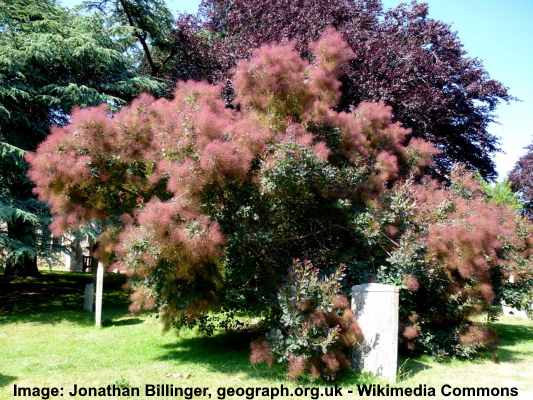
Smoke tree is an ornamental tree due to its colorful foliage and plumes
A smoke tree has several uses to add visual appeal to a garden landscape. The plant’s colorful foliage, smoky plumes, and informal habit add unique textures and plant combinations in a front or backyard.
The most spectacular smoke trees, such as the ‘Royal Purple,’ are ideal for planting as a specimen bush or colorful focal point. Additionally, with some pruning to maintain its height, a smoke tree can act as attractive foundation plantings. You can also plant smoke trees in rows to create an informal hedge.
Royal Purple Smoke Tree (Cotinus coggygria ‘Royal Purple’)
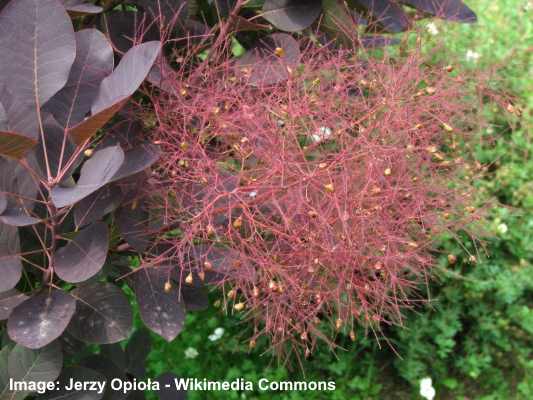
Cotinus coggygria (‘Royal Purple’) leaves and spent flowers
The ‘Royal Purple’ smoke tree is one of the most popular Cotinus plants. The outstanding characteristics of the purple smoke tree are oval to egg-shaped deep purple leaves, clusters of tiny yellow flowers that develop into wispy plumes, and a compact growth habit. The ‘Royal Purple’ smoke tree grows 10 to 15 ft. (3 – 4.5 m) high.
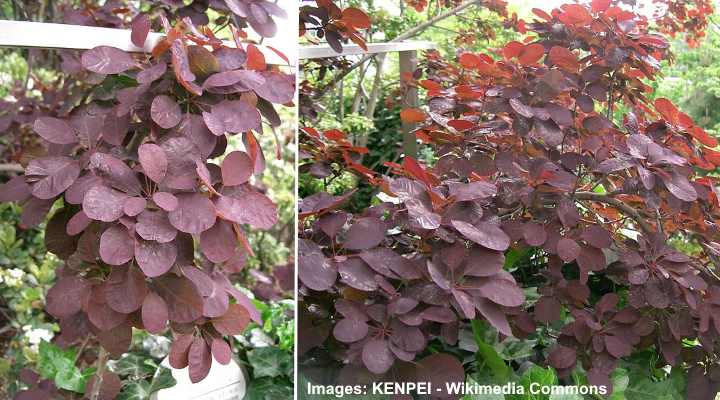
Cotinus coggygria ‘Royal Purple’ foliage
The purple smoke bush has a medium growth rate with an open, spreading habit. The ornamental bush is ideal for planting as an accent plant, border, hedge, or privacy screen. Being a relatively drought-tolerant shrub, the perennial plant is easy to maintain in most landscapes.
Smoke Tree Varieties
Let’s look briefly at some examples of smoke tree varieties with eye-catching foliage, wispy pink plumes, and attractive shapes.
Golden Spirit Smoke Tree (Cotinus coggygria ‘Ancot’)—This charming shrub has striking golden-yellow leaves that turn wine-red in the fall. The pinkish smoky plumes create an attractive contrast with the yellowish leaves during summer.

Cotinus coggygria ‘Golden Spirit’
Smoke Tree ‘Young Lady’ (Cotinus coggygria ‘Young Lady’)—This species is a small, compact shrub with medium green leaves that turn yellow and red in the fall. After blooming, fluffy plumes of pinkish green puffs cover the entire shrub.

Cotinus coggygria ‘Young Lady’
Smoke Tree ‘Velvet Cloak’ (Cotinus coggygria ‘Velvet Cloak’)—This smoke tree has lance-shaped purple foliage with pronounced pink-orange veins and a reddish-orange underside. Pink plumes cover the large, multi-branching shrub after flowering.
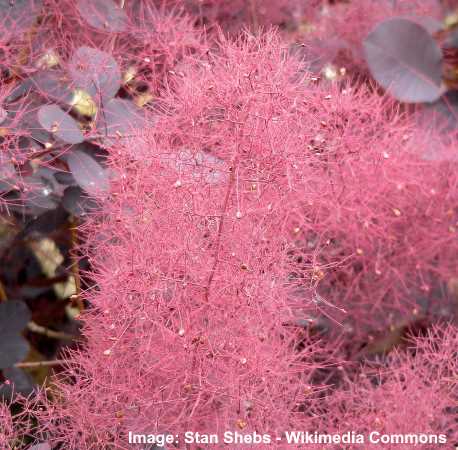
Cotinus coggygria ‘Velvet Cloak’
Smoke Tree ‘Grace’ (Cotinus coggygria ‘Grace’)—The ‘Grace’ smoke tree has some of the most spectacular leaves in the species. Large ovate leaves emerge deep red in spring before becoming a darker color throughout summer. In the fall, the leaves have orange and black tiger patterns on them.
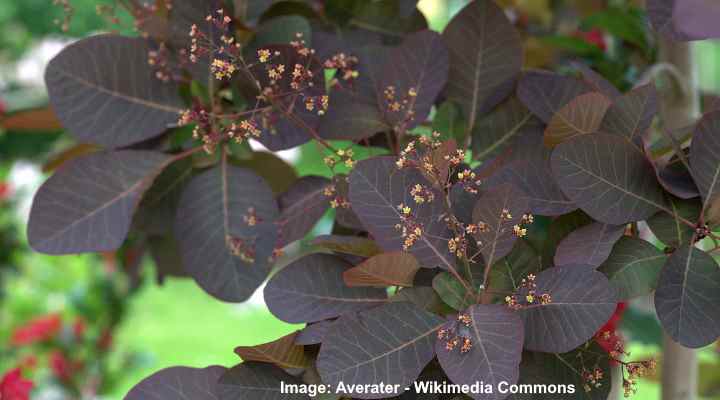
Cotinus coggygria ‘Grace’
Smoke Tree ‘Pink Champagne’ (Cotinus coggygria ‘Pink Champagne’)—Another popular cultivar is the ‘Pink Champagne’ smoke tree with its bronze-tinged spring leaves that turn pink through the season. Pink plumage covers the tree in summer.
Dwarf Smoke Tree ‘Winecraft Black’ (Cotinus coggygria ‘Winecraft Black’)—This miniature smoke tree is ideal for containers or compact gardens. The purple oval leaves turn almost black during summer. Then soft panicles of pink plumage grace the small shrub during summer.
American smoke tree (Cotinus obovatus)—The American smoke tree is a different species from the smoke bush varieties. This small to medium tree grows 20 to 30 ft. (6 – 10 m) tall, and its dense foliage consists of bluish-green ovate leaves. Like a smokebush, feathery plumes cover the tree in summer.
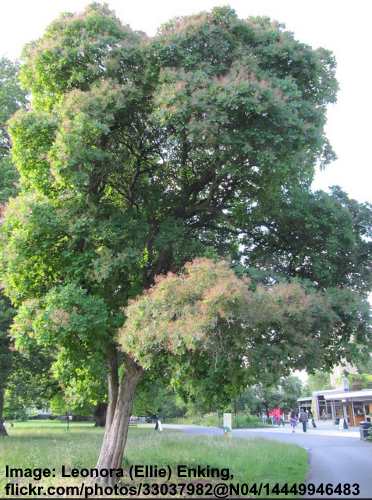
American smoke tree (Cotinus obovatus)
How to Plant a Smoke Tree
To plant a smoke tree in your yard, choose the sunniest spot with well-drained soil. Dig a hole twice the width of the root ball but at the same depth. It’s a good idea to amend the soil with 1 part compost to five parts loamy soil.
After untangling the roots, place the root ball in the planting hole, and backfill half of the hole. Then press down to remove any air pockets. Next, fill the remainder of the hole with the amended soil. To increase drainage, create a raised ring of soil 3” (7.5 cm) high around the root ball to prevent water pooling at the stem.
Lastly, add a layer of mulch around the root area, ensuring the depth is 2” to 3” (5 – 7.5 cm) and there is a gap of at least an inch (2.5 cm) around the central stem. Then water thoroughly. Until the smoke tree is established, water weekly.
How to Grow Smoke Tree in Pots
The best smoke tree plants for containers are the varieties that grow 4 to 8 ft. (1.2 – 2.4 m) or a dwarf variety. It is also necessary to use a sturdy pot with drainage holes to support a sizable shrub-like tree. The soil for a potted smoke tree should be loose and well-draining.
To grow a potted smoke tree, fill the container with a layer of stone chips. This adds extra weight and prevents the drainage holes from clogging up. Next, put the smoke tree root in the container, ensuring it’s growing at the same height as before.
Next, fill the space in the pot with a mixture of compost, peat moss, and perlite. Remember to leave a few inches (5 cm) from the top to prevent water from spilling over. Place the smoke tree container in a sunny spot in your container garden. Deeply water the plant whenever the top layer of soil is dry.
Smoke Tree Care — How to Grow Smoke Tree (Cotinus coggygria)
To care for a smoke tree, grow the plant in full sun, well-drained sandy or loamy soil, and water every ten to 14 days. Apply a layer of compost in spring to encourage healthy leaf development, good foliage color, and prolific blooming in late spring.
Where to Plant Smoke Tree in Landscape
Choose a sunny location in your yard where the smoke tree gets at least six hours of sunlight daily. A smoke tree will grow in partial shade; however, the foliage colors won’t be as vibrant, and the branches will be sparse.
Smoke trees are hardy plants. Therefore, you can plant them in any soil type and almost any pH level. They will even grow well in poor or rocky soils. But it’s good to remember that soggy soil or poorly draining ground will affect its growth.
When choosing the location for a smoke tree, there are a few considerations. Although the ornamental shrub grows well in zone 5, ensure it has enough protection from winter winds. Otherwise, the branches and foliage could suffer damage.
In warmer, humid climates, high air moisture can be an issue, resulting in fungal disease affecting leaves. Therefore, when growing smoke trees in zone 8, leaving enough space between them is vital if you usually get humid summers. Leave between 10 and 15 ft. (3 – 4.5 m) between central stems.
How to Water Smoke Tree
Once mature, only water a smoke tree every ten days to two weeks. Sufficient ground moisture helps keep the roots healthy and encourages plenty of feathery plumes to appear in summer.
It’s good to remember that smoke trees are relatively tolerant of drought. So, you should avoid overwatering the ground. So, as a rule, watering less, not more, is better for a smoke tree’s health.
Smoke Tree Temperature and Humidity Requirements
A smoke tree performs best in moderate temperatures. The best temperature range for smoke trees is in zones 5 through 8. However, some species are winter hardy in zone 4 and still grow well in zone 9. These hardy varieties are the ‘Royal Purple’ smoke tree and the ‘Golden Spirit’ smoke bush.
Generally, all species of smoke trees prefer drier climates where excess humidity isn’t a problem.
Fertilizing Smoke Tree for Healthy Growth
A smoke tree adapts well to all types of soils; therefore, it has minimal fertilizer needs. However, to encourage excellent foliage color and plenty of blooms, add a layer of organic compost to the root area in spring.
If you notice poor foliage growth, then applying a balanced, slow-release nitrogen-rich fertilizer before leafing out can encourage dense foliage.
Pruning Smoke Tree
Smoke trees have a natural, informal growth habit and require minimal pruning. However, in late winter or early spring, you should remove diseased branches. Depending on how you want the Cotinus plant to grow, there are various pruning techniques to achieve the desired result.
Pruning a smoke tree to encourage a bushy shrub: Hard prune the shrub back to 6” to 8” (15 – 20 cm) above the ground during the first two years after planting.
Pruning to grow a smoke tree: Cotinus is a suckering shrub-like tree. To ensure a tree shape, remove all suckers apart from the primary central stem. You should remove the stems throughout the year as they appear.
Pruning a smoke tree to encourage flowering: To get more flowers and feathery plumes on your smoke tree, remove about one-third of old stems every spring. Because smoke trees bloom on old wood, only prune every other year to prevent sparse flowering.
How to Propagate Smoke Tree
The easiest way to propagate a smoke tree is by taking stem cuttings. It’s advisable to use stem cuttings for propagation because this results in growing a similar tree. Propagating a smoke tree from seed may result in a shrub that looks different or fails to bloom.
To grow a new smoke tree from cuttings, remove a length of leafy stem that is 6” to 8” (15 – 20 cm) long—hardwood or softwood is fine. Then, remove the leaves from the lower part of the stem. Next, with a hardwood cutting, remove some of the bark from the cut end.
Dip the end in rooting hormone and plant in a moist, well-draining potting mix to root the smoke tree cutting. Then, cover the pot with a plastic bag to seal in moisture and keep the potting medium moist. Transfer the cutting to a larger pot when it is rooted.
Growing smoke tree from seeds
It is possible to propagate smoke trees from seeds. However, smoke tree seed propagation is tricky and prone to failure. The tiny seeds may not show any sign of germination or growth for two seasons. And, if a smoke tree grows, it may be infertile or not produce any blooms.
Therefore, propagating smoke trees from stem cuttings is the preferred method.
Pests and Diseases Affecting Smoke Tree Growth
The oblique-banded leafroller is the primary pest that affects smoke trees. This green caterpillar with a black head can feed on the foliage of smoke trees. The hungry larvae damage leaves, resulting in a plant with a withered and unsightly appearance. In some cases, the caterpillars can defoliate a small smoke bush.
Smoke trees growing in soggy soil can show signs of fungal disease like verticillium wilt. This disease causes leaf spot, and entire leaves can turn brown. The best way to avoid soil fungal issues is to ensure the ground drains well and you never overwater your ornamental garden plants.
Why is my Smoke Tree Not Blooming?
A lack of sufficient sunlight is the most common reason smoke trees fail to produce smoky plumes. This can happen when buds don’t get enough light in spring and they fail to open. Root rot or drainage issues could be another reason for poor blooming and no ‘hairy’ plumes on your attractive shrub.
Related articles:
